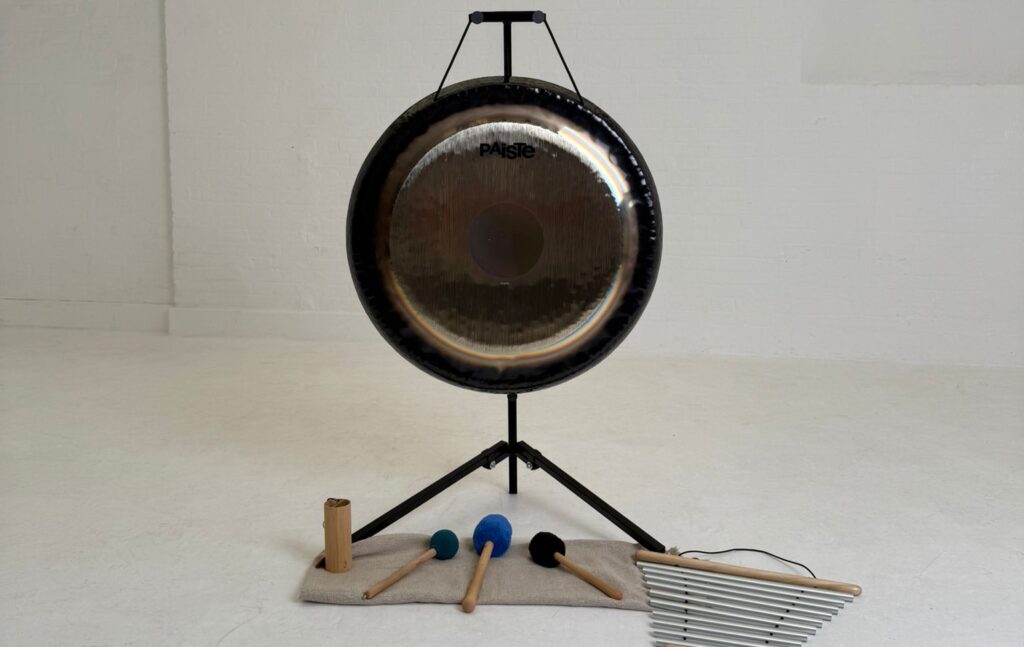
Sound Is All Around Us: Why a Sound Bath Supercharges a Gentle Yoga Practice
Even in “silence”, there’s sound — the fridge hum, leaves rustling, a distant car. And always, your breath. Some sounds spike stress (sirens, sudden bangs). Others are naturally soothing (waves, wind in trees). Pair those calmer frequencies with breath-led movement and you’ve got a surprisingly potent reset.
What actually is a sound bath?
A sound bath is an immersive listening experience using instruments like crystal or Tibetan bowls, chimes, or gongs. You lie down comfortably while a sound practitioner creates layers of gentle tones and harmonics. Many people report slipping into a deeply restful state — the body’s “rest and digest” mode — and emerging clearer and more at ease.
Why it pairs so well with yoga
Breath + steady tone = quicker calm. Slow breathing already down-regulates the nervous system. Add sustained, gentle sounds and you’ve got a simple anchor for attention.
Vibration invites softening. Low, warm frequencies can encourage muscles to release (especially when you’re supported on the mat).
From doing to receiving. After mindful movement, the body is primed to shift gears. Moving first, then receiving sound, often feels like more than the sum of its parts.
No grand promises — just practical pathways into ease.
What to expect at a yoga x sound event
A gentle flow first. Think: breath-led, beginner-friendly shapes to unclench shoulders and hips.
Then deep rest. You’ll settle onto mats with props and blankets; eyes open or closed — your choice.
Skilled facilitation. A sound practitioner (e.g., using singing bowls) guides the soundscape; the yoga teacher holds the space and cues comfort.
Plenty of consent. Volume, proximity, and duration can be adjusted. You’re encouraged to speak up about preferences.
Who tends to benefit
- Overthinkers who struggle to “switch off”.
- Beginners who find stillness confronting.
- Remote workers whose nervous systems are stuck “on”.
- Anyone wanting a safe, cosy way to unwind without performance or pressure.
A few access notes (so you feel safe)
Sound baths are generally gentle, but do chat to the facilitator first if you have tinnitus or sound sensitivity, migraine history, epilepsy, a pacemaker, first-trimester pregnancy, PTSD/trauma, or if you’re simply unsure. Easy modifications: sit up instead of lying down, choose greater distance from instruments, lower volume, or longer pauses between tones.
Aftercare that helps it “stick”
Keep the rest of your day simple if you can. Hydrate. Take a short walk. Notice what’s different: breath pace, jaw tension, how you respond to small stressors. Jot one sentence about how you feel — build a little feedback loop you can trust.
Try this mini “sound-aware” cool-down at home (6–8 minutes)
Arrive (60s): Sit quietly. Notice the farthest sound you can hear, then the nearest (your breath).
Gentle release (3–4 min): Cat–Cow, seated side bend, easy seated twist.
Humming (Bhramari-style, 60–90s): Inhale naturally, hum softly on the exhale 4–6 times. Rest between rounds.
Stillness (60–90s): Lie down, notice any shifts in your body and breath.
If humming isn’t comfortable, skip it and simply listen for steady, non-intrusive sounds (the “floor” of the room).
Why this matters at events like Root & Radiate
At Root & Radiate (7 September, Brixton) we move first — a soft, morning-adapted flow to settle the body — then the sound practitioner leads a gentle sound experience. You’re not there to “do” more; you’re there to receive. The combination helps people arrive in their bodies, let the mind unspool, and leave with a calmer baseline for the week ahead.
TL;DR
Sound + yoga helps many people downshift faster and stay present longer. It’s not about fancy poses or perfect stillness—it’s about giving your nervous system multiple doorways into ease. When you leave the room, the real practice begins: how you breathe when stressed, how kindly you speak to yourself, and how you show up for others.
